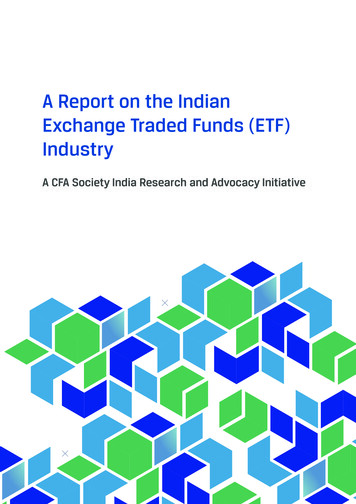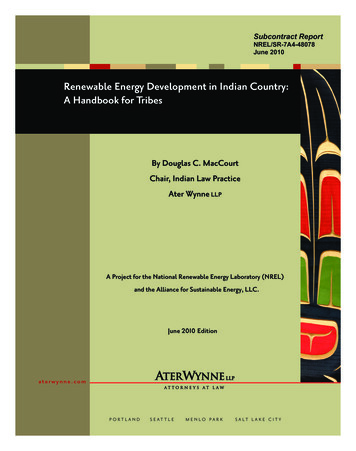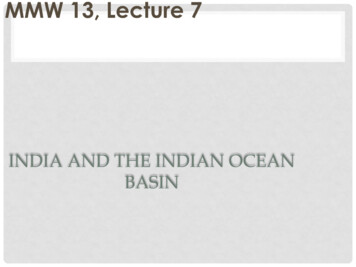
Transcription
A Report on the IndianExchange T raded Funds (ETF)IndustryA CFA Society India Research and Advocacy Initiative
A REPORT ON THEINDIAN EXCHANGE TRADEDFUNDS (ETF) INDUSTRYA CFA Society India Research and Advocacy InitiativeSIVANANTH RAMACHANDRAN, CFANILESH SAHA, CFA
Vision“The Professional body for ethics, excellence and thought leadership infinance”Mission“To enhance member value by providing professional and careerdevelopment opportunities, promoting highest standards of ethics &professional conduct and being a thought leader of the investmentprofession for the ultimate benefit of society”CFA Society India (Indian Association of Investment Professionals) is anassociation of investment professionals, consisting of Portfolio Managers,Security Analysts, Investment Advisers and other financial professionals.As one of the 157 CFA Institute member societies, CFA Society Indiaconnects local members to a global network of investment professionals.It is one of 17 XL societies in the world.Under the guidance of Mr. Rajendra Kalur, efforts of Research andAdvocacy committee are focused on contributing meaningfully towardsthe corporate governance and investor awareness. The committee hasthree main pillars of activities that include: 1) Working with Members topropagate standards of best practices, 2) working with regulators & mediato raise standards in the profession and 3) working with the investorsto promote awareness of CFA Charter and increase financial literacy.To achieve its objectives, committee engages with regulators and otheragencies in financial markets. 2020 CFA Institute. All rights reserved. No part of this publicationmay be reproduced, stored in a retrieval system, or transmitted, in anyform or by any means, electronic, mechanical, photocopying, recording,or otherwise, without the prior written permission of the copyrightholder. This publication is designed to provide accurate and authoritativeinformation in regard to the subject matter covered. It is sold with theunderstanding that the publisher is not engaged in rendering legal,accounting, or other professional service. If legal advice or other expertassistance is required, the services of a competent professional should besought.
ContentsI.Overview of the Indian ETF Industry 1II.A Brief Primer on ETFs 1a. Indian ETF Evolution 2b. Active vs Passive Landscape – US and India 3c. ETF Market Structure 4III.Tailwinds impacting the ETF Industry 6IV.Headwinds impacting the ETF industry 7a. ETF Design and Diversification Issues 7b. Liquidity 7c. ETF Market Structure 9d. Distribution 11V.Recommendations 11a. Improve Investor Awareness 11b. Improve ETF Ecosystem 12c. Remove Stamp Duty on ETFs 13d. Continue Using ETFs as Vehicles for Divestments 13VI.Conclusion: 13Appendix A: International ETF Evolution 15Bibliography 17IVCFA Society India
This page intentionally left blank
AcknowledgementsThe authors would like to thank eminent market practitioners who gave us their time andinputs during the course of this project; Mr. Anil Ghelani, Head of Passive Investmentsand Products, DSP Mutual funds; Mr. Mukesh Agarwal, CEO, Indices and Data, NationalStock Exchange; Mr. JatinVisaria, Senior Vice President, Indexes and Mutual Funds atUTI Mutual Fund; Ms. Bhavna Sadarangani, Head of Marketing and Communications,S&P Dow Jones Indices; Mr. Suresh Sadagopan, Founder of Ladder7 Financial Advisors;and Mr. Kaustubh Belapurkar, Director of Fund Research, Morningstar. Our special thanksto Mr. Sameer Desai, National Lead ETF, Nippon Asset Management Ltd, who graciouslyadvised us throughout the project.The authors would also like to thank Mary Leung, Head of Advocacy, Asia Pacific atthe CFA Institute, for her inputs on every iteration of this report, and challenging andsharpening our views and recommendations. The errors that remain, are our own.VICFA Society India
This page intentionally left blank
I.Overview of the Indian ETF IndustryThe rise of passive investingusing exchange traded funds (ETFs) is one of the long-term trendsin global investing. Ever since the first ETF, the NiftyBeeS was launched in 2001, the assetstracking the passive equity has grown in India to almost 20bn or 18% share of the equityfund industry in 2019, dominated by ETFs1. In this report, we would look at the Indian ETFindustry, various policy issues for consideration, and the way forward. Given the maturity ofthe US ETF industry, for context we will make qualitative and quantitative comparisons ofIndian ETF industry vis-à-vis the US wherever feasible.The rest of the paper is designed this way. Section II provides a brief primer on ETFs, includingthe evolution of Indian ETF industry, landscape, and a brief description of market structureand the various participants in the industry. Section III and IV describes the tailwinds and theheadwinds that impact the industry. Section V provides a few policy recommendations thatwould help further the development of the industry. Section VI concludes.Each section has been created for the readers to dip in and out of, and considerthe issues mostimportant to them.II.A Brief Primer on ETFsETFs can be thought of as a hybrid of mutual funds and stocks. Like mutual funds, theyrepresent a proportional interest in a pooled asset. Both mutual funds and ETFs are regulatedunder the Mutual fund regulations of 1996. But unlike mutual funds, ETF shares are tradedin continuous markets on global stock exchanges, can be bought and sold through brokerageaccounts, and have continuous pricing and liquidity throughout the trading day. Thus, theycan be margined, lent, shorted, or subjected to any other strategy used by sophisticated equityinvestors2.While both ETFs and index mutual funds are passive products with similar investment process,ETFs have distinct advantages over index mutual funds. ETFs are efficient vehicles comparedto index mutual funds. In mutual funds, the portfolio manager needs to buy and sell securitiesevery time an order is placed, incurring liquidity costs and potential capital gains. The costsand potential capital gains taxes are borne by all the investors in the mutual fund. Most of thetransactions in ETFs happens in the secondary markets, where the liquidity costs and capitalgains are borne by the investors engaged in the transaction, leading to greater efficiency andfairness.12Although we make a few comments on fixed income ETFs, we focus a large part of the report on equities.In India, some of the strategies are difficult absent a robust short-selling market.1CFA Society India
A Brief Primer on ETFsII.a. Indian ETF EvolutionThe chart below the evolution of Indian ETF industry. Although the first ETFs, first inequity and subsequently in money market and Gold were launched by Benchmark assetmanagement as early as 2001, the industry was dominated by Gold ETFs in the first fewyears. The first major reform was the budget 2013, when ETFs were included as an eligibleasset in the pension fund universe, and the securities transaction taxes were reduced to makeit in line with mutual funds. The government divestments in public sector enterprises throughthe ETF route, provided a major fillip in terms of investor awareness, as well as assets. Froma small asset base of Rs. 1,477 crores, representing 11% of overall ETF assets, other ETFs3(mostly equity) grew more than twice to Rs. 3,704 crores or 30% of overall assets. At the endof 2018, other ETFs accounted for 94% of the total assets.Chart 2a.1: Indian ETF EvolutionThe chart shows the Nifty TR index since 2001. The major events around ETFs are represented as callouts.3Surprisingly, most statistics including SEBI’s handbook of statistics continue to categorize equity ETFs under “other ETFs”,a relic of an era where Gold ETFs were dominant. 2020 CFA INSTITUTE. ALL RIGHTS RESERVED.2
A Report on the Indian Exchange Traded Funds (ETF) IndustryChart 2a.2: Indian ETF Assets Under Management Across Gold and EquitiesIndian ETF AuM - Gold vs Equity ETFs (Rs. Crores)Source: SEBI Handbook of StatisticsThe next major fillip came in the middle of 2015, when Employees Provident Fund Organization(EPFO) took tentative steps towards investing in stock markets via an ETF route, startingwith a modest 5% of incremental flows, which were subsequently hiked to 15% of incrementalflows in 2017.ETFs are regulated under SEBI’s mutual fund regulations 1996. However, specific diversificationnorms for index funds and ETFs were circulated in January 2019. These norms were modest,mandating a minimum 10 stocks in an ETF, restricting the individual stock weight to 25% (or35% for a thematic ETF) and top 3 weight to 65%. There were other rules aimed at liquidity.Lastly, India launched the first corporate bond ETF in December 2019, following a series ofpolicy moves, including the cabinet approval, SEBI’s norms for debt ETFs, and the reservebank tweaking its norms to allow debt ETFs to be eligible as collateral for repo transactions.For a description of how ETFs evolved globally, please refer to Appendix A.II.b. Active vs Passive Landscape – US and IndiaThis section shows the split between assets tracked by active and passive equity funds, for bothUS (a mature market) and India. We’ve included both the index funds and the ETFs withinpassive funds (almost all assets managed actively are structured as a mutual fund).In August 2019, US passive industry crossed a milestone – the assets managed by passive fundscrossed the ones by active funds by a whisker, according to Morningstar calculations (50.1% vs49.9%). Investors have pulled out of active funds and into passive in droves for the past few years.On surface, Indian passive industry dominated by ETFs, are doing well; it’s smaller but stillrespectable at 18% share, with strong positive flows into both active and passive funds in recentyears.3CFA Society India
A Brief Primer on ETFsChart 2b.1: Active vs Passive Equity funds - Assets under Management and NetflowsUS: Net Fund Flows AcrossActive and Passive Funds( bn)US: AUM Across Active andPassive Funds(Total -300Source: Morningstar. Data as of August 2019.II.c. ETF Market StructureIn this section, we will describe how Indian ETFs work, both in terms of primary markets aswell as secondary markets.The chart below shows the typical market structure of ETFs. The first part reflects the primarymarket transactions between the ETF sponsor and the Authorized Participants (AP) who areauthorized to create and redeem ETF shares. The second part shows the secondary markettransactions, where market makers create two-way liquidity using a variety of tools.Chart 2d.1: How Indian ETFs work – Primary Transactions 2020 CFA INSTITUTE. ALL RIGHTS RESERVED.4
A Report on the Indian Exchange Traded Funds (ETF) IndustryChart 2d.2: How ETFs work – Secondary TransactionsIn primary market, ETF shares are created and redeemed in pre-specified number of units(basket) by Authorized participants, which are firms that have agreements with the ETFmanager or distributor to create and redeem ETF shares at the NAV price at the end of eachday. If market prices deviate sufficiently away from the net asset value of the underlying basket,the AP can buy (sell) the “mispriced” ETF in the open market and redeem (create) it at NAVwith the issuer. With this creation and redemption mechanism, ETFs operate like mutualfunds, with the difference that only AP could create and redeem a pre-specified basket at NAV.Lastly, in addition to creation and redemption mechanism, APs have a range of tools to ensureETF prices are in line with the NAV. For example, APs could go long (short) the mispricedETF and short (long) other ETFs tracking the same index; APs could also create arbitragetrades using futures and options tracking the index, orshort the underlying basket of stocks /ETFs.Like stocks, ETFs are traded in secondary markets with bid and offer. The factors thatdetermine the width of a bid-ask spread are the amount of ongoing order flow, the amountof competition among market makers for that ETF, and the actual costs and risks associatedwith an AP doing the creation/redemption process, and the expected profit margin. Althoughit works the same way in India, given the low order flows and continuous two-way quotes,liquidity is a challenging issue we’ll discuss later.There are minor differences in ETF market structure between India and rest of the world.Some of them are beneficial; for example, ETFs generate capital gains during rebalancing orcreation / redemption process. ETF sponsors globally are liable to pay capital gains taxes; inIndia such capital gains are not taxed. However, other market structure differences, such asdirect redemption feature, may’ve unintended consequences. We will explore these issues inSection IV.With the background on ETF evolution as well as how they work, we’ll turn our attention tothe tailwinds and headwinds impacting the Indian ETF industry.5CFA Society India
Tailwinds impacting the ETF IndustryIII.Tailwinds impacting the ETF IndustryThe ETF industry has benefited from several tailwinds from the markets and regulations. It’snow well known that Indian active funds haven’t performed well in recent times. Accordingto the 2018 year-end SPIVA report, a little over 90% of the active funds in the large capequity category have failed to beat the benchmark on a 3-year basis, providing a strong casefor passive investing. Even in the mid and small cap segment, typically associated with greaterinefficiencies, 56% of the funds underperformed the corresponding index.nnnnn4Policy moves in recent years have provided a fillip to the passive industry. The moves wereaimed at making ETFs a favoured vehicle for asset sales for the government, providing atruer picture of active fund performance vis-à-vis benchmark, providing better disclosureson fees, as well as incentivizing fee-based advice.Government’s choice of ETF as investment vehicle for divestments for Central PublicSector Enterprises (CPSE), as well as choice of investment by EPFO since 2015 haveincreased awareness of retail investors in ETFs. Any possible future asset sales by thegovernment would also incentivize policymakers to develop ETF ecosystem further.In late 2017, SEBI came out with a set of 10 equity categories with precise definitions,and mandated fund houses to have only one scheme per category (SEBI, 2017). Thecategorization reduced the scope of mutual funds to stray outside the stated mandate - forexample, a large cap active fund benchmarked to Nifty investing a meaningful portionof its assets in small- and mid-cap stocks, and potentially showing an outperformance.Limiting the fund houses to only one scheme per category reduced the noise, andpotential for fund houses to cherry-pick the best schemes. The policy changes forcedgreater transparency into the active fund industry, and a more level-playing field with thepassive industry.In 2018, SEBI asked fund houses to benchmark returns of equity schemes against a totalreturn index (TRI) instead of price return index. Until then, the mutual funds used tobenchmark their total return (including dividends and after fees) with Nifty price index(excluding the impact of dividends4), providing a misleading picture of active fundperformance.Since SEBI came out with the investment advisor regulations in 2013, there has beenincreasing awareness about fee-based model vis-à-vis traditional distribution model.While nascent, fee-based Registered Investment Advisors (RIAs) who are held to a higherstandard of care compared to distributors, should help steer investors towards low cost andpassive funds over the long term.For reference, the dividend yield of Nifty Index was 1.31% at the end of September 2019. 2020 CFA INSTITUTE. ALL RIGHTS RESERVED.6
A Report on the Indian Exchange Traded Funds (ETF) IndustryIV.Headwinds impacting the ETF industryDespite the tailwinds and rising popularity, the industry faces a few headwinds. The oftencited issue is a lack of liquidity in most ETFs; There are other less-cited nuances on account ofmarket structure which has constrained the evolution of ETFs. Finally, there are downstreamissues at the level of distribution. While these issues are often inter-related, we will look atthem in turn.IV.a. ETF Design and Diversification IssuesIn most geographies where ETF’s constitute a large part of the ecosystem there are specificdiversification guidelines. In the US, for example, these form a part of the Generic ListingRequirement of ETF’s. These are a set of criteria that an enables an ETF to automaticallyget listed in an exchange without having to do an individual product filing with theregulator.While SEBI does not have an equivalent automatic listing process for ETFs, it came outwith its portfolio diversification norms for Equity ETFs in January 2019 and Debt ETFs inNovember 2019, described below:1.Equity ETF: Minimum 10 stocks; Max Single stock exposure capped at 25% weight;Weight of top 3 stocks capped at 65%.2.Debt ETF: Minimum 8 issues; Single exposure issuer capped at 15%; Only investmentgrade.In theory, defining such outer boundary for portfolio construction by regulations helpsspur product innovation. However, in practice, the resultant portfolios that adhere to thesenorms could still be very concentrated. For example, CPSE ETFs comprise of 10 stocksdominated by energy and materials sectors, with the top 4 stocks accounting for nearly80% of portfolio weight. The allocation to CPSE ETF by Employee Provident FundOrganization (EPFO), which has otherwise been conservative with its equity allocation, isperceived as problematic.IV.b. LiquidityThe liquidity of most of the Indian ETFs is modest. While US ETF flows are driven by bothadvisor as well as institutional flows, over 90% of Indian ETFs are owned by institutions,mainly the Employee Provident Fund Organization (EPFO).The dominance of one-way flows results in poor liquidity. The most liquid ETF in India,NiftyBees had less than one-hundredth of the daily traded value of Reliance Industries, a largeliquid stock. In contrast the most traded US ETF, SPDR S&P 500 ETF had 3.5 times thedaily trading volume of Apple5. While ETF liquidity is not a sole function of trading volumes,5Based on our calculations between Jun 2019 and Sep 2019.7CFA Society India
Headwinds impacting the ETF industrythe popularity of individual stocks vis-à-vis ETFs speaks volumes about the lack of marketmaturity in India. The Median of the daily Bid-Ask Spread on the largest ETF is as high as17 bps, which that of individual large cap stocks is less than 5 bps. In most geographies it worksthe other way around.To assess popularity, we analysed google search trends on mutual funds vs ETFs. The chartbelow shows that globally ETFs are popular compared to mutual funds; for a recent period,the number of searches on ETFs were 4 times those of mutual funds. In India however, mutualfunds are far more popular than ETFs, although relative interest have narrowed in recenttimes. Interestingly, the spikes in interest have coincided with the government divestments inpublic sector enterprises, a trend that is likely to continue.Chart IV.a.1: Google Search Trends as a proxy for PopularityWorldwide Google Search Trends:Mutual Funds vs ETFsIndia Google Search Trends:Mutual Funds vs ETFsThe liquidity problem manifests in two ways. Despite the efficiencies offered by the ETFstructure – in-kind transactions and fairness in allocating costs of trading, Indian ETFs areperceived as poorer alternatives to index funds tracking the same index. To compare the twostructures, we looked at the share-class returns of ETFs and index funds tracking the popular50-stock S&P CNX Nifty index for a set of large asset management firms. To preserve theiranonymity, we’ve denoted them as Firm1, Firm2, Firm5. On average, the ETF share-classreturns were about 50 bps higher. However, if liquidity costs such as the bid-ask spreads andthe impact costs of trading are high enough, it could potentially remove the performanceadvantage offered by the ETF structure. 2020 CFA INSTITUTE. ALL RIGHTS RESERVED.8
A Report on the Indian Exchange Traded Funds (ETF) IndustryChart IV.a.2. Three-year return of ETFs and Index ex 410.110.310.3522429.21149.835229Data as of 25 Sep 2019.The liquidity problem with the ETF market also manifests in how well the ETF prices tracksNAVs. To test this, we looked at 4 liquid Nifty ETFs and compared their price returns withthe index returns. In an ideal world, the median return difference would be the expense ratios(the typical expense ratio of Nifty ETFs is about 6 bps) and tracking error would be 0. Thecalculated standard deviations of daily returns were in the range of 18-30 bps.However, standard deviation doesn’t tell investors much about what kind of return they canexpect, whether the fund is over- or under-performing its index, or how frequent outliers arefor different holding periods (Hougan, Hill, & Nadig, 2015). A better way to look at trackingerror is to look at return differences over the investment horizon, say 12-months. By thismeasure the variation at 25th and 75th percentiles were much larger, in some cases over 50 bps6.In other words, an investor with a one-year horizon might out- or under-perform the index byover 50 bps, a quarter of the time.Our analyses focus only on Nifty, a popular index. ETFs tracking broader market (such asNifty 100 or BSE 200) or smart beta indexes are expected to be more illiquid.It may be argued that the liquidity issue in ETFs are salient because ETFs are transparent;the liquidity costs in mutual funds are internalized within the structure in the form of returnimpact. While there is merit to the argument, some of our comparisons of stock liquidity vsETF liquidity, as well as ETF prices vs. NAVs makes it clear that the lack of liquidity has ameaningful impact on investor experience.IV.c. ETF Market StructureIndian ETF industry also suffers from structural issues which flow from, as well as contributeto its unpopularity.Firstly, the role of authorized participants (APs) is not clearly differentiated from liquidityproviders such as market makers. Globally APs are employed by ETF sponsors, specialize in6Calculations based on returns data between Sep 2016 – Sep 2019. 12-month return differences were calculated on a rollingdaily basis.9CFA Society India
Headwinds impacting the ETF industryspecific ETF segments, put their own capital at risk and intervene when prices move away fromfair values due to market demand for ETFs. Market makers perform a much more tactical roleof providing daily liquidity. In fact, the European Systemic Risk Board points to a conflict ofinterest in the two roles during times of market stress, since arbitrage trades required to bringthe ETF price in line with the prices of the constituent securities may impose losses on APsthat can subsequently drain their capital and thus limit their liquidity provision, potentiallycreating a negative spiral (Pagano, Serrano, & Zechner, 2019).In any case, there aren’t many APs / market makers to support an ETF. A typical US ETF hasover 34 Authorized participants, with 5 active APs at any time. Even small ETFs ( 27M)have 2 active APs (Antoniewicz & Heinrichs, 2015). Although large Indian ETFs may haveabout 5 APs, few are active at any time and reasonably large limit-orders may take hours toclear absent a vibrant secondary market.Given thin volumes, the market making costs are (unsurprisingly) high. Whenever marketmakers receive any substantial trade from investors it is typically one sized and they don’t haveoffsetting orders. Hence, they have to go to the ETF manager for liquidity in lot increments.The major costs that the market maker experiences in this regard are:nnnCost of hedging: Market maker provides ETF units on Day T 0 whereas the units fromthe fund house are received on day T 1 in case of a buy trade.Cost of funds: The market maker has to provide funds to the fund house for unit creationon T 0 while the funds from the investor are received only on T 2Cost of carry: Any fractional units of lots that are not accepted by the investor has to becarried by the market maker because the liquidity in secondary market is so low.We interviewed 2 out of the 3 largest market makers in the Indian markets and they mentionedthat anecdotally the charges for these come to about 10 bps for each leg of transaction over andabove normal transaction charges.Indian Securities lending and borrowing (SLB) market is not very active. Securities lendingis an important enabler for short-selling and market-making programs, which in turn aidsliquidity in ETFs. It also has the potential to improve the performance of the ETF orprofitability of the fund sponsor, depending on how much of the revenue to passed through toshareholders. A Morningstar study noted that ETF sponsors could routinely offset between 5%and 50% of management fees through securities lending program (Morningstar, 2018). WhileSEBI has allowed SLB in liquid ETFs at least since 2012, the practices vary. An analysis ofScheme Information Documents (SID) reveal that some ETF sponsors do not engage in SLBaltogether, while others allow upto 20%. However, with the SEBI’s 2018 circular mandatingphysical settlement for stock derivatives in phased manner, the securities lending market isexpected to become more active (SEBI, 2018).Lastly, lack of robust hedging instruments such as futures and options also hinder ETFliquidity. Liquidity providers such as ETF arbitrage desks routinely trade in ETFs and futureswhen prices deviate too far from the fair value. While contracts are traded on the popular Niftyindex, the mid-cap Nifty Next 50, an index which is tracked by several ETFs lacks a futurescontract. 2020 CFA INSTITUTE. ALL RIGHTS RESERVED.10
A Report on the Indian Exchange Traded Funds (ETF) IndustryFund houses, recognizing the liquidity problem permit direct creation and redemption. Thecreation mechanism is available to large investors in multiples of ETF creation units, the valueof which could be as low as Rs. 1 million for some ETFs; the redemption is made contingenton large discount to NAV, absence of quotes for consecutive days, or lack of secondary marketvolume. While these measures help large investors in the fund, they also act as a backstop,preventing market participants who might otherwise trade. They also lessen the distinctionbetween an ETF and an index fund.IV.d. DistributionOne of the biggest impediments to ETF adoption relates to lack of incentives for ETFdistribution. Firstly, ETFs in India (like it is elsewhere) do not pay trail fees. Fee-onlyregistered investment advisors are a recent phenomenon, but their reach pales in comparison todistributors. It is rare for retail investors to pay for advice when making investments in ETFs.Given the vast disparity between the expense ratios of mutual funds and ETFs – median assetweighted expense ratio in equity funds were 1.93% according to Morningstar 2019 InvestorExperience Study, while the cheapest ETFs carried an expense ratio of 5 bps (excludingliquidity costs) – there is little incentive for mutual funds to promote investments in ETFs,even in the face of underperformance in active funds. That said, there has been increasinginterest from high net worth individuals and family offices for investments in ETFs and otherpassive investments. Wealth platforms have increased access to ETFs in response.The second impediment relates to the logistical frictions in trading ETFs. An investor in mutualfund needs to open a separate brokerage account, and till recently, it was not straightforwardfor advisors to trade in ETFs on client’s behalf 7. While interest in index mutual funds (devoidof these frictions) haven’t really increased either, such frictions have been occasionally cited bymarket participants as a hassle.V.RecommendationsThe CFA Society India believes Indian investors would benefit from knowledge and accessto passive low-cost investment options. They would also benefit from a level-playing fieldwhere they could evaluate the costs and benefits of investing in active funds vis-à-vis passivefunds, which as we’ve seen from the report is not always the case. Our recommendations coverinvestor awareness, ETF ecosystem, and distribution.V.a. Improve Investor AwarenessSEBI Chairman in his speech in August 2019 highlighted that ETFs are yet to catch the fancyof retail investors and expressed concern over the lack of progress in encouraging investmentsin ETFs. AMCs charge 2 bps for investor awareness initiatives, and half of the budget managedby AMFI. Given the disparity in expense ratios between active and passive funds, there is aperceived lack of incentive when it comes to increasing awareness of low-cost products. For7Changes to SEBI (Investment Advisor Regulations) 2013 allowed implementation services through direct schemes/productsin the securities markets to investment advisors for the convenience of investors (SEBI, 2020).11CFA Society India
Recommendationsexample, AMFI’s Mutual-funds-Sahi-Hai (Mutual funds are right) ad campaign, runningsince 2017, only recently started promoting commission-free Direct plans. There is still nopromotion on the use of passive funds, or the use of fee-based registered investment advisors.We believe the regulators and exchanges should take a lead in increasing awareness in ETFs,and continue to nudge the industry in this regard.Another issue with investor awareness charge is that index funds and ETFs are low costproducts, with most broad-based ETFs having total expense ratios (TERs) in the range of1-10 bps. A 2 bps charge is quite high in comparison to their TERs. It makes sense to link theinvestor awareness charge to TER as much as net assets.
CFA Society India (Indian Association of Investment Professionals) is an association of investment professionals, consisting of Portfolio Managers, Security Analysts, Investment Advisers and other financial professionals. As one of the 157 CFA Institute member societies, CFA Society India











